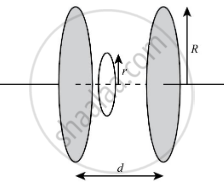Advertisements
Advertisements
Question
Choose the correct answer:
A parallel-plate capacitor has circular plates of radius 8 cm and plate separation I mm. What will be the charge on the plates if a potential difference of 100 V is applied across its plates?
Options
1.78 × 10-8C
1.78 × 10-5C
4.3 × 104C
2 × 10-9C
Solution
1.78 × 10-8C
Explanation:
The capacitance of a parallel plate capacitor is given as follows:
C = `(ε_0A)/d`
Here, ε0 is the permittivity of free space, A is the plate area, and d is the separation between the plates.
For circular plates as shown in the above figure, the area of the plates can be calculated as follows:
A = `piR^2`
Therefore the capacitance can be expressed as:
C = `(ε_0 piR^2)/d` .....(1)
Substitute 8 cm for R, 1 mm for d, and `8.85 xx 10^-12 CV^-1 m^-1` for ε0 in equation (1) to find the value of C.
C = `((8.85 xx 10^-12 CV^-1 m^-1)*(3.14)*(8 xx 10^-2 m^2)^2)/(1 xx 10^-3 m)`
C = `1.78 xx 10^-10 CV^-1`
The charge on the capacitor is given as follows:
Q = CV .....(2)
Substitute 100V for V and `1.78 xx 10^-10 CV^-1` for C in equation (2) to find the value of Q.
Q = `(1.78 xx 10^-10 CV^-1) * (100V)`
Q = `1.78 xx 10^-8 C`
